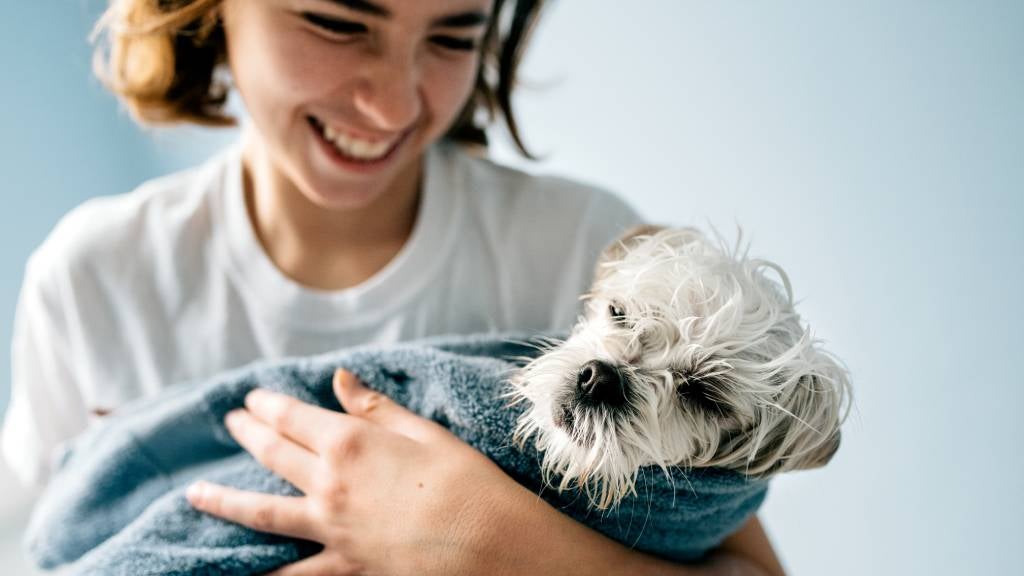Tips for grooming your pet at home

After a muddy bush walk, a splash at the beach or a cheeky roll in sheep poo, our pets often need a tidy up. Home grooming is one of the easiest ways to keep them clean and comfortable, and it can also turn into a calming routine that strengthens your bond.
It’s also one of the easiest ways to spot health issues early and stop bigger problems from developing. Grooming is an important part of animal welfare because it supports both comfort and long-term health.
Why home grooming is important
Regular animal grooming isn’t just about keeping your pet looking sharp, but it is also a way to keep on top of their health. By running your hands over their body, you can detect lumps, wounds, parasites, or mats in the coat. Small issues caught early can be easier to treat and less costly in the long run.
Grooming is also about connection. Just like tummy rubs or playtime, brushing your pet can be a calming ritual that builds trust. For dogs, the benefits of grooming are clear: reduced shedding, healthier skin, and improved coat condition.
Creating a calm grooming routine
A good grooming session should feel like a treat, not a chore.
- Start young: Puppies and kittens are more adaptable, so get them used to brushing, nail checks and gentle handling while they’re still curious and playful.
- Short sessions: A few minutes is enough at the beginning, and you can build up from there.
- Set the mood: A quiet spot with minimal stressful distractions (such as other pets) helps your pet relax, while a favourite treat or enrichment item can distract them in a positive way.
- Positive reinforcement: Praise, pats, and kai treats encourage positive associations.
According to the SPCA, Fear Free grooming approaches help reduce stress and build trust. Cooperative care techniques use reward-based training to encourage pets to voluntarily participate in grooming. If you’re unsure where to start, veterinarians, allied veterinary professionals, professional groomers, dog trainers, and breeders can offer advice and guidance on grooming routines and claw trimming.
Tools and products
The right tools make dog grooming or cat grooming safer and easier. Slicker brushes, combs, or undercoat rakes may be needed depending on the coat.
Human tools usually don’t work well on animal fur, so it’s worth checking with a vet or professional groomer before buying. Always patch test shampoos or sprays to avoid skin reactions, and lean towards unscented or lightly scented products.
Breed-specific grooming tips
Different coats have different needs, and tailoring your approach helps avoid discomfort.
- Double-coated dogs like Huskies and German Shepherds should not be shaved, as their coat insulates against both heat and cold. Regular brushing to remove dead undercoat is best.
- Curly-coated breeds such as Poodles and Bichons need frequent trims to stop knots forming, often with a professional groom every 6–8 weeks.
- Short-haired breeds, including Beagles, Staffies or Labradors, don’t need clipping but still benefit from weekly brushing to remove loose hair and boost circulation.
- Long-haired cats often develop mats. While shaving might seem like a fix, it can expose delicate skin to sunburn, so regular brushing to prevent mats forming is safer.
- Rabbits and guinea pigs also need gentle brushing to prevent fur blockages in their digestive tract and matting in long-haired varieties.
Healthy coats are part of a bigger picture of care, alongside essentials like desexing and keeping animals safe at home. Together, these steps help pets live longer, happier lives.
What to avoid when grooming your pet
Some tasks are better left to professionals. Anal gland expression, ear hair plucking, or tartar removal should only be done by a veterinarian. Human shampoos, scissors, or clippers aren’t safe for pets, and strongly scented products can irritate sensitive skin.
When it comes to bathing, many owners wonder how often they should wash their dog. Bathing dogs is generally not necessary if the dog is kept in a clean environment, but it can reduce odours that are unpleasant to humans. This may vary on breeds, but it’s important to be informed.
Breed, lifestyle, and skin health all play a role, but over-bathing can strip natural oils. Parasite prevention is also part of coat care, and routine grooming pairs well with treatments such as dog flea and tick protection.
During summer, it’s important to watch out for grass seeds. They can penetrate the skin, ears, and between the toes of dogs, causing discomfort or infection. Pet parents should check their dogs regularly for grass seeds, especially in the late summer months.
Know your limits
Stop if your pet becomes distressed and try to work out why before you try again. While toothbrushing is an excellent way to help prevent tooth disease if your pet will tolerate it, don’t try to remove tartar or discolouration from teeth. This needs to be done by a veterinarian under anaesthetic.
Claw care is equally important. Regular nail trimming helps prevent overgrown claws, which can cause pain or difficulty walking. Use sharp clippers or a dremel, taking care not to damage the quick. Dogs can also benefit from scratch pads or boards to help maintain claw length, while cats enjoy access to scratching posts.
When to call a professional
Professional help is best if your pet has a severely matted coat, if grooming causes them high stress, or if you’re unsure how to safely trim nails or manage their specific coat type.
With a little patience and the right tools, you can learn what’s normal for your pet and pick up on changes early that may need vet intervention. And if the unexpected does happen, SPCA Pet Insurance may be of help with vet bills. Get a quote today to see what level of cover may suit you and your pet.
21 Nov 2025
